Mark Sisson's Blog, page 100
July 22, 2019
Compound Butter
 As Mark has always said, the key to great food is the sauces and seasonings. This simple and versatile compound butter is yet another way you can add more flavor and richness to just about any Primal or keto meal you make. Fresh herbs add a bright taste and butter lends a smooth richness to everything from roasted vegetables to hearty omelettes to varied fish and meat dishes. Use your favorite herbs for the perfect taste you’ll enjoy!
As Mark has always said, the key to great food is the sauces and seasonings. This simple and versatile compound butter is yet another way you can add more flavor and richness to just about any Primal or keto meal you make. Fresh herbs add a bright taste and butter lends a smooth richness to everything from roasted vegetables to hearty omelettes to varied fish and meat dishes. Use your favorite herbs for the perfect taste you’ll enjoy!
?
Compound Butter
Ingredients:
1 stick butter (softened at room temperature)
1 Tbsp. fresh parsley
1 Tbsp. fresh basil
1 Tbsp. fresh oregano
1/2-1 Tbsp. fresh thyme
Note: If using dried herbs instead of fresh, cut the amount of herbs in half
Instructions:
If using fresh herbs, wash, dry and roll together into a “cigar” shape, and finely slice, gathering up the herb pieces and cutting the pile until the pieces are very small. (If you’re using dried herbs, combine in a small bowl.)
Place the chopped herbs in the same small bowl as a stick of softened butter. Use a fork to mash the butter and combine the herbs with the butter.
When combined, place the compound butter on a small sheet of waxed paper or parchment paper, and roll into a log. Twist the ends to seal. Refrigerate for an hour to harden.
Take a tablespoon or more to add to omelettes, roasted vegetables, meats, or other dishes for added flavor and richness.
Note: To maintain freshness, store in the refrigerator in the rolled paper and a plastic container.
Other flavor options: chipotle powder, chili powder, cumin, fresh garlic, tarragon.

Nutritional Information (1 tablespoon = 1 serving):
Calories: 82
Total Carbs: 0 grams
Fat: 9.2 grams
Protein: 0 grams

The post Compound Butter appeared first on Mark's Daily Apple.



July 21, 2019
EVO Hemp Cauliflower Oats
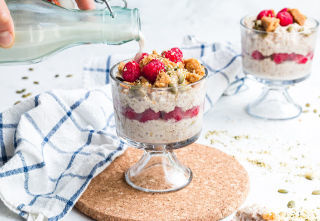 Hemp and cauliflower “oats” is a hearty and filling breakfast that has the traditional texture—without the grains. You can modify the recipe dozens of different ways by varying fruits, nuts, seeds, natural sweeteners, milks, and other toppings. While this recipe used full-fat coconut milk and water, you can use dairy milk or another non-dairy alternative you prefer. We also added collagen for an extra protein boost. Find your favorite taste combination, and enjoy this Primalized classic.
Hemp and cauliflower “oats” is a hearty and filling breakfast that has the traditional texture—without the grains. You can modify the recipe dozens of different ways by varying fruits, nuts, seeds, natural sweeteners, milks, and other toppings. While this recipe used full-fat coconut milk and water, you can use dairy milk or another non-dairy alternative you prefer. We also added collagen for an extra protein boost. Find your favorite taste combination, and enjoy this Primalized classic.
Servings: 2
Time in the Kitchen: 15 minutes
Ingredients:
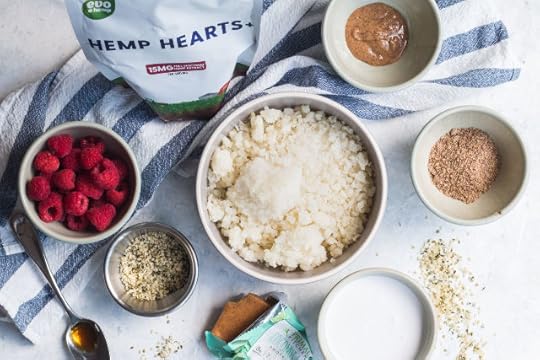
2 1/2 cups Frozen Riced Cauliflower
½ cup + 2 Tbsp. Coconut Milk
½ cup Water
2 Tbsp. Ground Flaxseeds
½ Tbsp. Almond Butter
3 Tbsp. Pumpkin Seeds, divided
1 tsp. Vanilla Extract
1 1/2 Tbsp. EVO Hemp Hearts
2 Scoops Primal Kitchen® Vanilla Coconut Collagen (optional)
½ cup Raspberries (or sub your favorite berry)
Optional Toppings: Maple Syrup, Hemp Hearts, crumbled Primal Kitchen Coconut Lime Bar
Instructions:
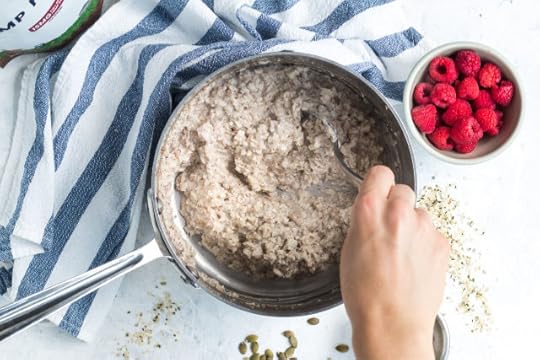
In a pot, combine the cauliflower, coconut milk, water, and ground flaxseed and heat over medium heat. Stir occasionally.
Once it starts to bubble (about 3-4 minutes), add the almond butter and give the mixture a stir. Reduce the heat to medium low and cover the pot. Heat for an additional 5 minutes, removing the lid occasionally to stir.
Take half of the pumpkin seeds and pulse them quickly in a grinder, blender or food processor so they are chopped small but not yet in the form of a powder. Pour the pulsed pumpkin seeds in the pot and stir. Cover the pot again for an additional 2-3 minutes.
When you uncover the pot again, add the vanilla extract and hemp hearts. Around this time it should start resembling thin “oats.” If you are adding the Collagen Fuel, any sweeteners, or additions like cinnamon, add them now. Gently stir the oats uncovered over medium-low heat so it is just bubbling until the mixture reaches the consistency of your liking (keep in mind that it will continue to thicken a small amount after it is removed from heat).
(If the mixture seems too thick, you can add a small amount of additional water or coconut milk. If the mixture is still too soupy and thin, you can either try adding ground flaxseed a teaspoon at a time or continue to cook the mixture uncovered until it reaches your desired thickness.)
Pour the “oats” into a glass or bowl and top with raspberries, a sprinkle of hemp hearts, the remaining pumpkin seeds, and any other favorite add-ons you may have!
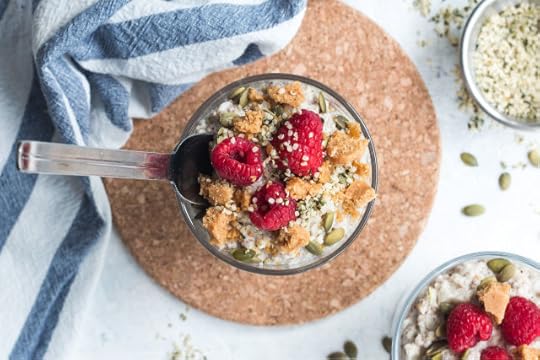
Nutritional Information (2 servings, per serving):
Calories: 444
Total Carbs: 20 grams (Net Carbs: 11 grams)
Fat: 28 grams
Protein: 31 grams

The post EVO Hemp Cauliflower Oats appeared first on Mark's Daily Apple.



July 19, 2019
Weekly Link Love — Edition 38

Research of the Week
Weight lifting without weights… works?
Exercise fights off Alzheimer’s.
Capping medical resident training hours at 80 per week didn’t hurt patients.
When you train to failure, the load and volume don’t matter.
Now they’re considering a saturated fat tax.
Swapping out dairy fat for plant fat results in a reduction in key nutrients.
New Primal Blueprint Podcasts

Episode 356: Dr. Jason Bussanich: He was a doctor who destroyed his adrenal function and gut health with too much exercise, and got it back by going carnivore.

Episode 357: Jay O’Hare: Host Brad Kearns chats with ultrarunner Jay O’Hare about the anti-inflammatory healing effects of CBD.

Episode 358: Paul Saladino, MD: I sit down with Paul Saladino to talk carnivore.
Each week, select Mark’s Daily Apple blog posts are prepared as Primal Blueprint Podcasts. Need to catch up on reading, but don’t have the time? Prefer to listen to articles while on the go? Check out the new blog post podcasts below, and subscribe to the Primal Blueprint Podcast here so you never miss an episode.
Media, Schmedia
New cancer therapies that use your own cells are very promising but extremely expensive.
Interesting Blog Posts
How to get affordable grass-fed beef.
Success Stories
How Jonathan Geiman reinvented his relationship with food.
Bodybuilder Susan Hoff’s Primal Health Coach success story.
Social Notes
Everything Else
A mom runs a 3:11 marathon while pushing 185 pounds of stroller-bound child.
Would you drink this?
Changes in global meat consumption over the last 50 years.
Whenever you’re in Athens, try this meat place.
Of course “cow cuddling” is real and costs $300 a session.
Things I’m Up to and Interested In
Video I found interesting: Geoffrey Miller’s take on what the paleo movement gets right and wrong about sexual fitness.
Conspiracy theory I’m enjoying: That the Pentagon weaponized ticks in the 70s and released them into the public.
Does this even taste good?: New Starbucks Tie-Dye frappuccino has 3 days’ worth of sugar.
I guess I knew this, but the video evidence really hammers the point home: Lions are strong.
Question I’m Asking
How would you react to a tax on sources of saturated fat? Remember that this would increase prices of dairy, meat, eggs, and coconut oil.
Recipe Corner
Improve that Caprese by adding chicken.
Stuff these stuffed sliders into your mouth.
Time Capsule
One year ago (Jul 14 – Jul 20)
7-Minute Pre-Bed Yoga Flow – Nice way to unwind before bed.
CrossFit vs. Bodybuilding– The differences and similarities.
Comment of the Week
“Collagen! I’m 56 and can still jump off of the roof of my house with no ill effects.”
– Unless you’ve got two stories this means nothing, Al Saunders.

The post Weekly Link Love — Edition 38 appeared first on Mark's Daily Apple.



July 18, 2019
27 Primal Lunchbox Ideas
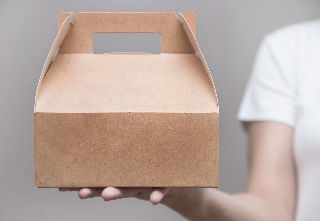 Packing a lunch day after day saves money and helps you stick to your health goals, but it requires some regular inspiration. From simple no-cook Bento box lunches, to layered Big-Ass salads, to big-batch recipes that provide dinner and lunch the next day, we’ve got you covered. Pack something good every day of the week with these go-to Primal lunchbox ideas.
Packing a lunch day after day saves money and helps you stick to your health goals, but it requires some regular inspiration. From simple no-cook Bento box lunches, to layered Big-Ass salads, to big-batch recipes that provide dinner and lunch the next day, we’ve got you covered. Pack something good every day of the week with these go-to Primal lunchbox ideas.
Big-Ass Salads
Put together several Big-Ass salads and store them in glass mason jars so you can grab the pre-made salads for lunch throughout the workweek. Dressing goes in the bottom of the jar and the salad ingredients are layered on top. This keeps everything crisp and fresh, even if you pack the salad a few days in advance. When you’re ready to eat lunch, dump the contents into a bowl and voila! You’ve got yourself a Big-Ass salad.

Tips For Packing Jar Salads:
Use quart-sized jars for main course salads and pint jars for side salads
Wide mouth jars are easiest to pack
Most mason jar salads can be packed up to 3 days ahead of time
Pour 2 to 4 tablespoons salad dressing in the bottom of the jar
Layer ingredients from firmest in texture to lightest, so the salad doesn’t get soggy
Greens are the last ingredient to go in the jar. Tear larger leaves into bite-sized pieces. It’s okay to pack the greens in tightly.
Mason Jar Big-Ass Salad Inspiration:
Greek Salad: Thinly sliced red onion, cooked ground lamb or sliced lamb , large diced cucumber, feta, Kalamata olives, spinach
DIY Dressing: Dill Vinaigrette
Primal Kitchen® Pairing: Greek Dressing
Nicoise Salad: Canned olive oil-packed tuna or sardines, cold potatoes, hard-boiled egg slices, green beans, halved cherry tomatoes, romaine lettuce
DIY Dressing: Parsley Dressing
Primal Kitchen Pairing: Italian Vinaigrette
Chopped Chicken Salad: Leftover cooked, shredded or sliced chicken, thinly sliced red bell pepper, grated carrots, chopped green onion, slivered almonds, shredded cabbage
DIY Dressing: Asian Dressing
Primal Kitchen Pairing: Sesame Ginger Vinaigrette
More Delicious Jar Salads:
Harvest Bowl with Honey Mustard Vinaigrette
Bento Box Lunches
Bento box lunches offer a variety of flavors and foods with very little effort. The trick is keeping your kitchen well stocked with healthy whole foods that require little or no prep time. Just open your fridge and pantry, pull a few things out, and pack up your bento lunch box.
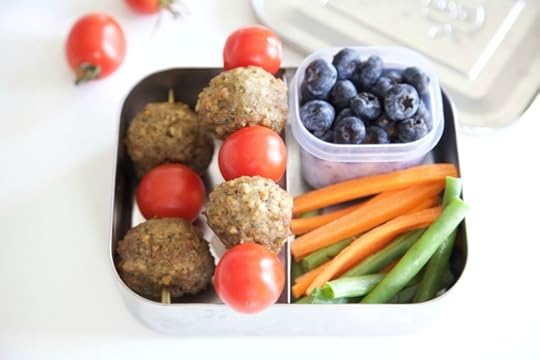
Bento Lunch Box Inspiration:
Canned olive oil-packed tuna with Primal Kitchen Mayo + Sweet mini bell peppers + Olives + Fresh berries with coconut butter
Smoked Salmon + Cucumber + Avocado + Green beans drizzled with sesame oil + Dried Seaweed (nori or SeaSnax)
Primal-approved jerky (no sugar or additives) + Hard-boiled egg + Carrot slices with Primal Kitchen Ranch Dressing + Apple slices and nut butter
Primal-approved cooked sausage (no sugar or additives) + Parmigiano-Reggiano cheese shavings + Cherry tomatoes with fresh basil (or pesto) + Raw Almonds
Other Bento Box Ingredient Ideas:
Greek Yogurt
Macadamia Nuts
Cooked Bacon
Meatballs
Chicken Drumsticks
Cooked Sweet Potato Slices
Primal/Keto Muffins
Peanut Butter Protein Cookies
For more kids’ bento box ideas, check out this post.
Leftover Lunches
Not sure what to pack for lunch? The answer might be in your fridge already. It’s called “leftovers.” Packing lunch is always easier when there are dinner leftovers in the fridge. These 9 recipes make big batches of food, providing both dinner and lunch the next day.
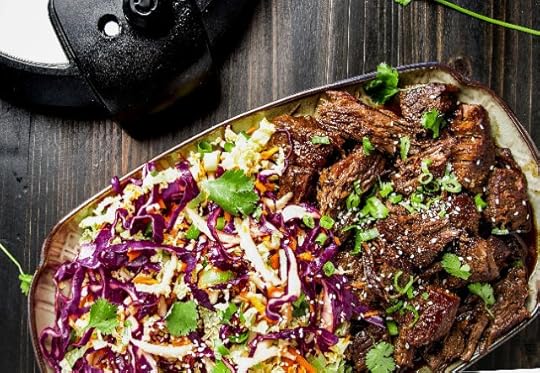
Chicken Cacciatore
Tender chicken thighs are cooked in a rich sauce made from tomatoes, mushrooms, bell peppers and garlic. Packing fresh garnishes in your lunch box like basil, grated Parmigiano-Reggiano cheese and black olives will give leftover chicken cacciatore fresh, bright flavor.
Sheet Pan Shrimp and Broccoli
This simple sheet pan meal is just as good the next day eaten as a shrimp and broccoli salad. Buy a bag of baby spinach to toss with the leftover shrimp and broccoli for lunch and don’t forget to dress the salad with Primal Kitchen Sesame Ginger Vinaigrette.
Sweet Potato Chili
Chili tastes better a day or two after it’s made, which means it’s a perfect leftover for lunch. With a simple list of ingredients and a short cooking time, this smoky sweet potato chili is sure to become a regular weeknight dinner that also provides lunch the next day.
Instant Pot Short Ribs With Sesame Ginger Slaw
These short ribs are so good you’re going to be counting down the minutes until lunch so you can eat them again. And the short ribs are tasty hot or cold (especially with the cool and sweet tasting slaw), so you’re good to go without reheating.
Layered Taco Casserole
A pan of casserole in the fridge is always a welcome sight. Especially when it’s Primal taco casserole. Pack this layered taco casserole with an avocado and small containers of salsa and sour cream and you’ll have a filling and delicious lunch.
Buffalo Chicken Casserole
Traditional buffalo chicken flavors are baked into this gluten-free, low-carb casserole. Better yet, this recipe is from Meal Prep on Fleek, which provides step-by-step instructions for meal prepping four meals from this one recipe.
Honey Mustard Chicken
Leftover chicken thighs for lunch? Yes, please! These thighs are flavored with a sweet and buttery mustard sauce that’s Whole30-Approved and Paleo friendly.
Instant Pot Coconut Ginger Pork Shoulder
A big cut of meat means you’ll get several meals from one recipe. This shredded pork flavored with coconut milk and ginger is easy to make, since all the cooking is done in an Instant Pot.
Instant Pot Brisket with Potatoes
Sliced brisket with potatoes is the type of leftover lunch that makes coworkers envious. Pack a few sprigs of fresh parsley to scatter over your meal, plus a little sea salt and a wedge of lemon to perk up the flavors of the meat and potatoes.
Thoughts or other ideas to add to the mix? Share them below, and have a great end to the week, everyone!

The post 27 Primal Lunchbox Ideas appeared first on Mark's Daily Apple.



July 17, 2019
Collagen vs. Whey: Which Protein is Best For Your Needs?
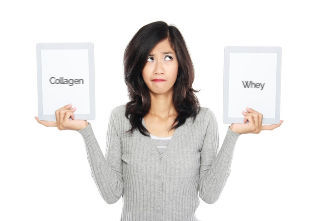 Collagen or whey. Which should you choose?
Collagen or whey. Which should you choose?
For years, collagen/gelatin was maligned by bodybuilding enthusiasts as an “incomplete protein” because it doesn’t contain all the essential amino acids, nor does it contribute directly to muscle protein synthesis. There’s definitely truth to this. If you ate nothing but gelatin for your protein, you’d get sick real quick. That’s exactly what happened to dozens of people who tried the infamous “liquid protein diet” fad of the 70s and 80s, which relied heavily on a gelatin-based protein drink. Man—or woman—shall not live by collagen alone.
As for whey, it’s an extremely complete protein. It’s one of the most bioavailable protein sources around, a potent stimulator of anabolic processes and muscle protein synthesis. I consider it essential for people, especially older ones in whom protein metabolism has degraded, and for anyone who wants to boost their protein intake and get the most bang for their buck.
This said, which is best for your needs today? Let’s take a look….
Collagen and whey are two completely different foods. Whether you take one or the other depends on a number of factors.
The first thing to do is explore the different benefits and applications of whey and collagen.
Whey Protein: Uses and Benefits
Whey is one of two primary dairy proteins, the other one being casein. It gained its reputation in the fitness world as a proven muscle-builder, but it actually has some interesting health effects that have little to do with hypertrophy.
In fact, whey is more than just protein. It also includes bioactive components such as lactoferrin (which improves bone health), beta-lactoglobulin (which can promote glutathione synthesis and protect against allergy), alpha-lactoalbumin (which can improve resistance to the cognition-depleting effects of stress), and immunoglobulins (which have antimicrobial effects). Whey also turns into some interesting peptide metabolites upon digestion which, according to a review, can improve blood lipids and lower blood pressure.
What Are Some Good Applications Of Whey?
Obesity: Whey tends to reduce fasting insulin levels in the obese and overweight (but not healthy prepubertal boys, who could use the growth promotion), increase satiety, reduce food intake, and improve resting energy expenditure. If you’re trying to lose weight or prevent obesity, you can’t ask for a better trifecta than increased energy burning, increased satiety, and reduced intake.
Diabetes: Eaten before a meal, whey reduces the glucose spike from the subsequent meal in non-diabetics and type 2 diabetics alike. It achieves this by “spiking” insulin, but transiently; the insulin area under the curve improves even as the immediate insulin response increases. Plus, as seen above, fasting insulin tends to lower in people consuming whey protein. Spikes are not persistent elevations.
Fatty liver: In obese women, a whey supplement reduces liver fat (and as a nice side effect increases lean mass a bit). Fatty liver patients also benefit from whey, enjoying improvements in glutathione status, liver steatosis, and antioxidant capacity. Rats who supplement with whey see reduced fat synthesis in the liver and increased fatty acid oxidation in the skeletal muscle.
Stress: In “high-stress” subjects, a whey protein shake improved cognitive function and performance by increasing serotonin levels. The same shake had no effect on “low-stress” subjects. And dietary whey also lowers oxidative brain stress, at least in mice.
Cancer: Both the lactoferrin found in whey and the glutathione synthesis whey promotes may have anti-cancer effects. Lactoferrin shows potential to prevent cancer that has yet to occur and induce cell death in existing cancer cells. In a recent human study, oral lactoferrin suppressed the formation of colonic polyps. And in animal cancer studies and human cancer case studies, whey protein has been shown to increase glutathione (“foremost among the cellular protective mechanisms”) and have anti-tumor effects.
HIV: People with HIV experience a drastic reduction in glutathione levels. As the master antioxidant, getting glutathione higher is pretty important. Whey won’t cure anything, but it does improve CD4 (a type of white blood cell) count, lower the number of co-infections, and persistently increase glutathione status.
Cardiovascular disease: Last year, a review of the effect of whey on major cardiometabolic risk factors found that whey protein improves the lipid profile, reduces hypertension, improves vascular function, and increases insulin sensitivity and glucose tolerance. Whey peptides that form during digestion actually act as ACE-inhibitors, reducing blood pressure similarly to pharmaceuticals without the side effects.
Sarcopenia: Muscle wasting, whether cancer-related or a product of age and inactivity, is a huge threat to one’s health and happiness. Studies show that whey protein is the most effective protein supplement for countering sarcopenia, especially compared to soy. An anti-sarcopenia smoothie I always have people drink on bed rest is 20-30 grams of whey isolate, a couple egg yolks, milk, cream, and ice. Tastes like ice cream and works like a charm. One time a friend even gave this to his grandmother who was on bedrest in the hospital with diarrhea, mental confusion, and a total lack of appetite. She was in a bad state. After a day or two of the smoothie, she recovered quite rapidly, regaining her appetite and alertness.
Gastrointestinal disorders: Dairy gets a bad rap in some corners for its supposed effects on the gut, but a component of dairy can actually improve gut health, even in patients with gastrointestinal disorders. In Crohn’s disease patients, a whey protein supplement reduces leaky gut. In rodent models of inflammatory bowel disease, whey protein reduce gut inflammation and restore mucin (the stuff used to build up the gut barrier) synthesis.
Oh, and whey is great for hypertrophy.
When To Choose Whey
So…
If you lift and want some extra protein, whey’s a great choice.
If you’re older and worry about your ability to metabolize and utilize protein, some extra protein via whey can help.
If you have any of the conditions listed above, whey’s a great choice. Do note that some of the benefits may stem from simply eating more protein than before. Whey itself may not be the whole cause; an extra slab of steak or a few more eggs could possibly have the same effect.
Along with foods like organ meats, egg yolks, and shellfish, I consider whey to be an important “supplemental food”—a food that acts like a high-density nutrition supplement, powerful in small doses and worth including in almost every diet.
Collagen Protein: Uses and Benefits
I advocate collagen protein as a fourth macronutrient. It’s different enough from whey and other “regular” proteins, serving a totally different function in the body.
If whey has been the gold standard for the muscle building amino acid profile for 30 years, collagen is the gold standard for supporting collagen-based structures in the body (fascia, ligaments, tendons, cartilage, skin, hair, nails). We don’t get much collagenous material in a normal diet these days, and meat proteins and/or plant proteins and/or milk, eggs, etc. don’t have the collagen peptides nor the ideal ratio of glycine, hydroxyproline, and other amino acids found abundantly in collagen. Furthermore, metabolism of the amino acids present in muscle meat deplete our reserves of glycine, thereby increasing the requirement even further. The more meat you eat, the more collagen you need.
Why We Need Collagen So Much These Days
This (non)relationship with collagen is extremely novel for our species. For millions of years up until very recently we ate nose to tail. We ate the entire animal. To give you an idea of how much collagen we’d have eaten, the average cow is about half muscle meat and half “other stuff,” which includes bones, skin, tendons, ligaments, fascia, and other bits extremely rich in collagen. That’s a ton of glycine and a far cry from eating nothing but ground beef and ribeyes. And more recently, even when we moved toward shrink-wrapped select cuts of meat and away from bones and skin, we still had jello. Then, when jello got maligned, we had nothing. So for the past 20-30 years or so, most Americans have had no appreciable source of collagen peptides in their diet.
Just based on what we know about human biochemistry, this is a disaster. The human body requires at least 16 grams of glycine per day for basic metabolic processes, yet we can only synthesize 3 grams, and the typical omnivorous diet provides just 2-3 grams per day, so we’re looking at an average daily deficit of 10 grams that we need to make up for through diet. Collagen is roughly 1/3 glycine, so that means we need to be eating about 30 grams of collagen per day to hit our 10 gram dosage. And in disease states that disrupt glycine synthesis, like rheumatoid arthritis, or on plant-based diets that provide little to no dietary glycine, we need even more.
I suspect a lot of pro athletes who have connective tissue issues could use even more collagen, especially since they’re exposing their tissues to such incredible stress. I know I did back during my competition days.
What Does Collagen Do For Our Bodies?
It supports our connective tissue and collagen-based structures: fascia, ligaments, tendons, cartilage, skin, hair, and nails.
It improves sleep quality. Human studies show that 3 grams of glycine taken before bed increases the quality of your sleep and reduces daytime sleepiness following sleep restriction. Now that’s isolated glycine rather than collagen, but collagen is the best source of glycine. I can say that a big mug of bone broth or a couple scoops of collagen peptides before bed knock me out and give me great sleep.
It balances your muscle meat intake. I mentioned this earlier, and we see both observational and interventional evidence for it.
Observational: In one recent observational study, the relationship between red meat and diabetes was abolished after controlling for low-glycine status. People with low glycine levels and high meat intakes were more likely to have diabetes; people with higher glycine levels could have higher meat intakes without any issues. In another study, low circulating levels of glycine predicted diabetes risk.
Interventional: In both worms and rodents, excessive intake of methionine (the amino acid most abundantly found in muscle meat) reduced longevity, while adding in glycine restored it.
It improves gut health. When I gave up grains and stopped endurance training at age 47 my gut health improved immensely. Like, world-changing for me. But I was still at 90-95%. When I started supplementing with collagen, my gut finally had that last 5% of repair/support/healing it needed to get to 100%.
It’s a great pre-workout. Though maybe not for the reasons most people take “pre-workouts.” I’ve also experienced rapid healing of tendinitis through using pre-workout collagen with vitamin C. I’m not just imagining it because I’ve dealt with a ton of tendon issues over the years, and they never healed that quickly until I introduced pre-workout collagen.
I’ve noticed that my hair and nails grow much faster than before.
Final Answer: Which One?
So, should you use whey or collagen? Let’s get to the bottom line, Sisson.
I made Primal Fuel because I wanted a high quality, low-sugar, moderate-fat meal replacement whey protein.
I made Collagen Fuel and Collagen Peptides because I wanted an easier way to get more collagen into my diet.
Personally, I had a need for both.
If I had to choose one, collagen is a better choice for the vast majority of you.
Essential amino acids aren’t a big problem on most ancestral diets, like paleo, Primal, or Primal-keto, and if you’re eating enough animal protein you don’t really need whey. Now, can you benefit from whey despite eating meat? Sure. Necessary does not mean optimal; whey has been shown to improve hypertrophy and muscle recovery from resistance training, plus all the other benefits I already detailed earlier. Almost anyone who does anything in the gym will see benefits from adding 20 grams of whey per day.
But almost no one is getting enough collagen, even the ancestrally-minded eaters who are aware of its importance. And that is a historical aberration on a massive scale. It hasn’t been done before. I wouldn’t recommend testing those waters.
And of course, powders aren’t the only way to get collagen and whey. They both appear in plenty of foods. The powders are just convenient to have on hand when you forget to make the bone broth (chicken, beef, turkey) or throw the oxtails in the crockpot. (Check out those linked recipes if you prefer broth or stew sources.)
Which do you prefer—whey or collagen? What benefits have you noticed from each?
Thanks for reading, everyone. Let me know your thoughts, and take care.

References:
Wodarski KH, Galus R, Brodzikowska A, Wodarski PK, Wojtowicz A. [The importance of lactoferrin in bone regeneration]. Pol Merkur Lekarski. 2014;37(217):65-7.
Markus CR, Olivier B, De haan EH. Whey protein rich in alpha-lactalbumin increases the ratio of plasma tryptophan to the sum of the other large neutral amino acids and improves cognitive performance in stress-vulnerable subjects. Am J Clin Nutr. 2002;75(6):1051-6.
Pal S, Ellis V, Dhaliwal S. Effects of whey protein isolate on body composition, lipids, insulin and glucose in overweight and obese individuals. Br J Nutr. 2010;104(5):716-23.
Hall WL, Millward DJ, Long SJ, Morgan LM. Casein and whey exert different effects on plasma amino acid profiles, gastrointestinal hormone secretion and appetite. Br J Nutr. 2003;89(2):239-48.
Shertzer HG, Krishan M, Genter MB. Dietary whey protein stimulates mitochondrial activity and decreases oxidative stress in mouse female brain. Neurosci Lett. 2013;548:159-64.
Bounous G. Whey protein concentrate (WPC) and glutathione modulation in cancer treatment. Anticancer Res. 2000;20(6C):4785-92.
Meléndez-hevia E, De paz-lugo P, Cornish-bowden A, Cárdenas ML. A weak link in metabolism: the metabolic capacity for glycine biosynthesis does not satisfy the need for collagen synthesis. J Biosci. 2009;34(6):853-72.
The post Collagen vs. Whey: Which Protein is Best For Your Needs? appeared first on Mark's Daily Apple.



July 16, 2019
Tips for Doing Keto Without Dairy
 I love dairy. As a man of primarily Northern European descent, my ancestors have been consuming the stuff for thousands of years. It doesn’t give me any issues. You won’t find me chugging tall glasses of straight milk these days, but I’m a big believer in cream, cheese, yogurt, and kefir. Very nutrient-dense food if you can handle it. Lactase persistence? I practically have lactase insistence.
I love dairy. As a man of primarily Northern European descent, my ancestors have been consuming the stuff for thousands of years. It doesn’t give me any issues. You won’t find me chugging tall glasses of straight milk these days, but I’m a big believer in cream, cheese, yogurt, and kefir. Very nutrient-dense food if you can handle it. Lactase persistence? I practically have lactase insistence.
My favorable response to dairy makes keto especially easy. High-fat and fermented dairy is high in nutrients and low in digestible carbs (the bacteria consume most of the lactose). Cheese, cream, kefir, and yogurt all happen to be the most nutritious forms of dairy and the most keto-friendly. Many others getting into keto lean heavily on dairy. It just makes keto easier, especially if you’ve grown up eating dairy.
But globally my reaction to dairy is pretty rare, and that changes the keto landscape for most people.
Most of the world has some degree of lactose intolerance, meaning once weaned from breast milk they no longer retain the digestive enzyme required to comfortably break down the milk sugar lactose. A smaller but still significant chunk of people have dairy protein intolerance; they get an inflammatory or allergic response to the proteins found in dairy, most commonly casein. And there’s also the problem of A1 casein, a relatively novel form of dairy casein that has been shown to cause inflammatory issues in the guts of susceptible people, whereas the more “ancestral” form of casein—A2 casein—does not. A1 casein is far more common these days, and not everyone can handle it or find access to A2 casein-producing dairy animals.
In other words, there are many people reading this blog interested in going keto who either cannot or don’t want to consume dairy. They need tips for doing it dairy-free. And today, I’m going to give them some.
Before anything, make sure you actually are dairy or lactose-intolerant. I wrote a post explaining how to determine whether you truly are intolerant of dairy, as well as some suggestions for overcoming it (if possible).
If you know you’re dairy intolerant or choose to avoid dairy for other reasons, here are a few tips for keto eating dairy-free.
Explore Cream Alternatives
If you prefer cream in your coffee, it doesn’t have to be heavy whipping cream. Other options exist.
Coconut milk/cream: Pretty simple stuff. Coconut cream is richer and heavier.
Coconut butter: Just add a spoonful or two and blend to combine.
Coconut milk powder: This is another option. I use it in my Primal Fuel and Collagen Fuel products.
MCT oil powder: I’ve never been a big fan of the straight-up MCT oils. They’re fine if you like adding oil to your coffee, but I really prefer using the powdered MCT oil. The way I do it is mix a scoop or two with a little liquid—milk (although not if you’re avoiding dairy), coconut milk, water, etc—and then add the resulting slurry to the coffee.
Cashews: Cashews are a great creamer replacement because they have a natural sweetness to them. They’re also very rich in fat and low in fiber for a nut, so they promote extreme creaminess when blended. Some of my favorite Indian curries use cashews blended into water as the base instead of heavy cream or yogurt.
Tahini: A fantastic alternative to heavy cream is to blend tahini (sesame seed butter) with coconut milk and a teaspoon of blackstrap molasses. I normally blend the tahini into a bit of heavy cream, but coconut milk or cream also work. Don’t fear the few carbs in that teaspoon of blackstrap molasses; it’s key. You’ll find a nice coffee recipe using tahini here.
Macadamia cream: Blend macadamia butter (make by throwing mac nuts into a food processor) with a bit of water. Mac nuts are almost pure fat, so they make a fantastic creamer base.
Hemp: As I mentioned in one of my recent Sunday With Sisson emails (subscribe to the newsletter to receive those if you’re interested), one of my latest favorites is using 2-3 TB whole hemp hearts, a scoop of Vanilla Collagen Fuel, a dash of salt and cinnamon, and blending it all together until frothy and creamy. The hemp provides a ton of magnesium and creaminess, the Fuel gives collagen and rounds it out, and the salt and cinnamon provide flavor, sodium, and a little extra barrier against insulin resistance. All told, it’s a great way to enhance your coffee and provide many of the nutrients you need while ketogenic.
Eggs: Primal egg coffee. Egg yolks are also great thickeners for sauces where you’d normally use cream or butter.
Non-dairy milks: Read all about the relative benefits and drawbacks of the various non-dairy milks, then make your choice.
Get Enough Calcium
Yeah, yeah, conventional wisdom sources are obsessed with people missing out on calcium if they choose to eschew dairy, and they get so much about nutrition so wrong that it’s easy to ignore that one, too. They’re not wrong though. Dairy is a good source of calcium, perhaps the best, and definitely the easiest and most available. And although one reason why people feel they need so much calcium for good bone health is that they’re walking around with vitamin D deficiency—which impairs calcium metabolism—you do need calcium.
How do you get calcium on a dairy-free keto diet?
Eat bone-in fish. Canned sardines are a really easy, really delicious way to do it. An average can provides about 20% of your daily calcium requirements. Trader Joe’s has a great bone-in, skin-on wild pink salmon in a BPA-free can. If you eat all 7 servings in the can, you’ll hit 70% of your calcium requirements plus 35 grams of fat, much of which is omega-3, and 90 grams of protein. You could even slow cook whole bone-in fish until the bones soften enough to eat.
Cook bones or bone-in meat in acidic liquid. The old practice of adding a splash or two of apple cider vinegar to your bone broth pot doesn’t actually extract any measurable calcium from the bones. To really extract calcium, you need lots of acidity. An old Chinese postnatal meal was spare ribs cooked in vinegar (and sugar, but you can leave that out); the vinegar extracted huge amounts of calcium from the bones, giving the mother a much-needed source of calcium as she nursed her child. Cook ribs, shanks, or make bone broth using an acidic liquid like red wine or a high vinegar:water ratio. The Chinese vinegar sauce had a pH of 3.2, so you’ll want to aim for something in that realm of acidity. Red wine runs between 3.3 and 3.5 pH.
Eat collard greens. Some of the other calcium plant sources are also quite high in oxalates, which can bind to calcium and inhibit its absorption. Collard greens have less oxalate than most others and plenty of calcium. They’re also delicious cooked in some bacon fat, bone broth (maybe the high-calcium bone broth from the last section, even), and vinegar.
Focus On Whole Foods Rather Than Isolated Fats
Lots of keto people use dairy as a crutch. They drink cream by the cupful. They eat blocks of cheese like apples (not a bad thing, necessarily). They eat bowls and bowls of stevia-sweetened whip cream. They throw sticks of butter in their coffee. All of this in a quest to “get more fat.” These are good foods, to be sure (it’s a great crutch), but I don’t think they should form the basis of your caloric intake. They should enhance a meal, not replace it.
What if instead of subbing in buckets of coconut cream, cashew cheese, and MCT oil, you ate more eggs, meat, and salads? You don’t need to drink shots of olive oil or avocado oil. You can add them to your salad along with some olives and avocado. You can eat actual foods. Actual meals.
This applies to people eating dairy, too. But if you’re dropping dairy and are interested in 1-to-1 isolated fat sources, perhaps use this opportunity to switch over to a whole foods-focus.
Be Prepared
A big reason keto folks rely on dairy so much is that it’s easy. It’s right there, ready to be poured (kefir, cream), sliced up (cheese), spread (butter), or scooped out (yogurt, cottage cheese).
If you’re like most people, and you don’t have unlimited time to whip up amazing meals at the drop of a hat, you need to be prepared. You need to go shopping and get easy-to-prepare and prepared foods.
Charcuterie/cured meats, boiled eggs, cooked bacon, olives, nuts, seeds, canned fish, smoked oysters.
Cook meals ahead of time, or make enough for leftovers. A cold chicken leg or cold NY strip steak sliced up are some of my favorite “easy” meals.
Salad makings prepared and on hand (veggies, lettuces, dressings).
Coconut butter on hand for those times you just need a spoonful.
Primal Kitchen® fare—this is pretty much the reason I started making mayo, dressings, and bars. I wanted something I could travel with and just have on hand whenever I wanted.
Most of all, don’t sweat it too much. Dairy isn’t essential. Dairy isn’t necessary. You’ll do just fine with or without dairy.
What about you folks? Do you do dairy? Do you not? How do you approach keto without dairy?
Thanks for reading, everyone. Take care!

The post Tips for Doing Keto Without Dairy appeared first on Mark's Daily Apple.



July 15, 2019
Primal+Keto Cooking Made Easy: Mark’s Big-Ass Omelette
 Omelettes are a regular go-to for me. There’s no faster or easier way to whip up a healthy and filling meal than this. If I’m not eating a big-ass salad for lunch, you can bet it’s an omelette instead. Eggs offer a good dose of protein as well as plenty of essential minerals. Veggies, meat and a little cheese add their own nutrients and make for constant variety. It’s one of those Primal-keto staples I never get tired of. Let’s dig in.
Omelettes are a regular go-to for me. There’s no faster or easier way to whip up a healthy and filling meal than this. If I’m not eating a big-ass salad for lunch, you can bet it’s an omelette instead. Eggs offer a good dose of protein as well as plenty of essential minerals. Veggies, meat and a little cheese add their own nutrients and make for constant variety. It’s one of those Primal-keto staples I never get tired of. Let’s dig in.
?
Mark’s Big-Ass Omelette
Servings: 1
Time In the Kitchen: 15 minutes
Ingredients:
3 large eggs
1/4 bell pepper
1/4 cup chopped mushrooms
1/4 cup chopped onion
1/3 cup chopped ham
3 Tbsp. feta cheese
Instructions:
Heat butter in a skillet over medium heat.
Crack three eggs in a bowl and whisk until well combined. Set aside.
Add veggies to the skillet and saute for a few minutes until cooked. Add salt and pepper to taste, if you’d like, and stir the veggies well. Add any pre-cooked protein you’d like to use (we used diced ham in this version) and warm for 20-30 seconds.
Add whisked eggs to skillet. Allow to cook for a couple of minutes, scraping down the sides of the skillet with your spatula every now and then. Swirl the eggs around a bit with your spatula as the eggs start to cook on the bottom of the pan.
When the eggs are mostly set, sprinkle some cheese, if desired, on the eggs before folding the omelette over. Using your spatula, lift up one side of the eggs and very carefully flip that side over top of the other side.
Carefully slide the omelette out of the pan and onto a plate. Serve immediately with a side of bacon or sliced avocado if desired.
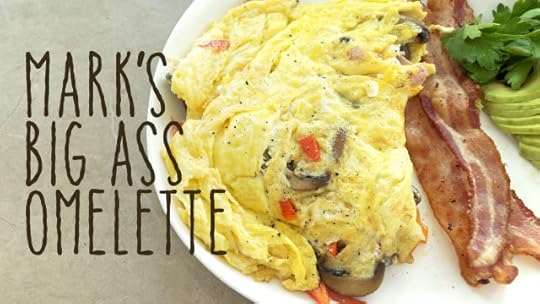
Nutritional Information:
Calories: 406
Carbs: 10.8 grams (9.8 net carbs)
Fat: 24.6 grams
Protein: 33.7 grams

The post Primal+Keto Cooking Made Easy: Mark’s Big-Ass Omelette appeared first on Mark's Daily Apple.



July 14, 2019
Keto Salted Caramel Ice Cream
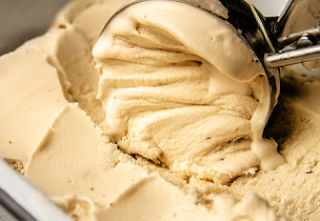 Sea salt caramel is no kiddie flavor (although more discerning children may love it). In fact, sea salt caramel may be one of the most nuanced and decadent ice cream varieties out there…. Something about the caramel flavor feels richer than other ice creams. Something about the sea salt offers a bite that satisfies beyond taste imagination. It’s where sweet meets depth. And with this recipe, it’s an indulgence you can still revel in—even while keto, thanks to the magic of Swerve.
Sea salt caramel is no kiddie flavor (although more discerning children may love it). In fact, sea salt caramel may be one of the most nuanced and decadent ice cream varieties out there…. Something about the caramel flavor feels richer than other ice creams. Something about the sea salt offers a bite that satisfies beyond taste imagination. It’s where sweet meets depth. And with this recipe, it’s an indulgence you can still revel in—even while keto, thanks to the magic of Swerve.
Pro tip: pour Mark’s cold-brew coffee over a scoop for the ultimate cool taste combo.
Servings: 6 half-cup servings
Time In the Kitchen: 45 minutes
Chill Time: 8 hours
Ingredients:
¾ cup Brown Swerve
3 Tbsp water
2 cups heavy cream (room temperature)
1 cup unsweetened almond milk (room temperature)
1/8 tsp fine sea salt
6 large egg yolks (room temperature)
1 teaspoon flaky sea salt (such as Maldon)
Instructions:
In a medium pot over medium heat, melt 3/4 cup Brown Swerve sugar with 3 tablespoons water, swirling skillet frequently, until Swerve turns mahogany brown in color (it should be almost but not quite black). This should take around 10 minutes.
Add heavy cream, almond milk, 1/8 tsp salt, and simmer until cream mixture is completely smooth and warm. Remove pot from heat. In a separate bowl, whisk yolks. While whisking constantly, slowly pour about a third of the warm cream into the yolks, then whisk the yolk mixture back into the pot with the cream.
Return pot to medium-low heat and gently cook until mixture is thick enough to coat the back of a spoon (about 170 degrees on an instant-read thermometer). This should take between 25-30 minutes. You want to avoid cooking ice cream mixture too fast because the egg could curdle.
Cool mixture to room temperature. Cover and chill in refrigerator overnight or for 8 hours.
Strain through a fine-mesh sieve into ice cream machine. Churn in ice cream machine according to manufacturer’s instructions. Sprinkle flaky sea salt into base during the last 2 minutes of churning. Serve directly from the machine for soft serve, or store in freezer until needed. Enjoy!
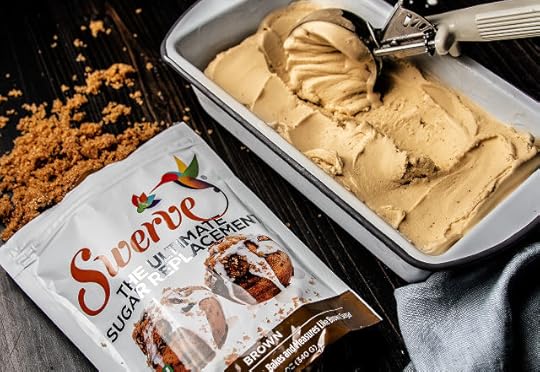
Nutritional Information (per serving):
Calories: 325
Carbs: less than 1 gram
Fat: 37 grams
Protein: 3 grams
(For more information on how Swerve is metabolized, see this blog post.)

The post Keto Salted Caramel Ice Cream appeared first on Mark's Daily Apple.



July 12, 2019
Weekly Link Love — Edition 37
 Research of the Week
Research of the WeekA very low carb high fat diet fails to impair exercise performance.
During immobility, heat treatment maintains muscle mitochondrial activity and staves off atrophy.
Lifting weights while you diet leads to almost exclusively body fat loss.
High maternal HbA1c linked to autism.
New Primal Blueprint Podcasts

Episode 355: Leland Conway: Host Elle Russ chats with the award-winning broadcaster who changed his life by following Primal principles.

Primal Health Coach Radio, Episode 18: Hosts Erin and Laura chat with Jonathan Posey, founder of an advocacy group that protects the rights of health coaches to practice.
Each week, select Mark’s Daily Apple blog posts are prepared as Primal Blueprint Podcasts. Need to catch up on reading, but don’t have the time? Prefer to listen to articles while on the go? Check out the new blog post podcasts below, and subscribe to the Primal Blueprint Podcast here so you never miss an episode.
Media, Schmedia
How youth basketball—and sport specialization in general—is threatening the health of young athletes.
Modern humans may have been in Europe 210,000 years ago.
Interesting Blog Posts
Jumiles, the edible wonder bugs of Mexico.
What’s the optimal exercise modality for mood boosting?
Social Notes
Interesting Twitter thread on the safety or toxicity of Bt corn.
Everything Else
Ah, camp season.
How are decisions made, if at all?
The fit young folks who ended up with bowel cancer.
As the permafrost melts, ancient organisms are waking up.
Things I’m Up to and Interested In
Restaurant I’d try: The one where the waiters have dementia and there’s no guarantee you’ll get what you order.
I’m entirely unsurprised: Snack sales spike in states with legal cannabis.
I like this idea: What if you trained your cognitive skills like an athlete?
I enjoyed this article: What we can learn from shipwrecked “microsocieties.”
I agree: When considering the effects of “saturated fat,” you can’t ignore the food matrix.
Question I’m Asking
Do you ever train your learning/brain/cognitive skills like athletes train their bodies?
Recipe Corner
Tuna poke bowls that rival Hawaii’s.
Curry tuna salad in pepper boats.
Time Capsule
One year ago (Jul 7 – Jul 13)
Keto for Women: 7 Tips to Make it Work – What should women watch out for?
Ultimate Guide to Allulose Sweetener– All about allulose.
Comment of the Week
“I found the Ancestral Health lifestyle in late 2008, thanks in part to Mark’s Daily Apple. Turned 50 last year but feel like I’m in my 30s. I’m aiming for strongevity!”
– Always glad to have you along, Aaron. I like “strongevity”!

The post Weekly Link Love — Edition 37 appeared first on Mark's Daily Apple.



July 11, 2019
Is 50 the New 70? How the Modern Lifestyle Is Remaking Middle Age
 “Do not go gentle into that good night.” That’s one of my favorite lines in all of literature, and it informs my outlook on health, life, wellness, and longevity.
“Do not go gentle into that good night.” That’s one of my favorite lines in all of literature, and it informs my outlook on health, life, wellness, and longevity.
Live long, drop dead. Compression of morbidity. Vitality to the end. All that good stuff.
But I’m sorry to report that Dylan Thomas imploring you to assail life with boldness is becoming harder for the average person to fulfill and embody. People more than ever before are heading into middle age with a head-start on the degenerative changes to body composition and function that used to only hit older folks. They may want to go boldly into that good night, but their bodies probably won’t be cooperating.
Ignore the standouts for a moment. I’m not talking about that awesome granny you saw deadlifting her bodyweight on Instagram or the centenarian sprinter smoking the competition. I’m not talking about the celebrities with personal trainers and access to the latest and greatest medical technologies. I’m referring to the general trend in the greater population. All signs point to average men and women alike having more fragile bones, weaker muscles, and worse postures at a younger age than their counterparts from previous eras.
What Signs Point This Way?
Low Bone Density
These days, more men than ever before are developing the signs of osteoporosis at an earlier age. In fact, one recent study found that among 35-50 year olds, men were more likely than women to have osteopenia—lower bone mineral density—at the neck.
Why?
Osteoporosis used to be a “woman’s disease,” lower estrogen after menopause being the primary cause. That’s rather understandable; estrogen is a powerful modulator of bone metabolism in women, and a natural decline in estrogen will lead to a natural decline in bone density. Men’s bone density has a similar relationship with testosterone; as a man’s testosterone declined, so does his bone density. As long as a man or woman entered the decline with high bone density, the decline wouldn’t be as destructive.
But here’s the thing: these days, both men and women are starting the decline with lower bone density. In women and men, peak bone mass attainment occurs during puberty. In girls, that’s about ages 11-13. In boys, it’s later. Puberty sets up our hormonal environment to accumulate healthy amounts of bone mineral density—but we have to take advantage of that window.
One of the main determinants of bone density accumulation is physical activity. If you’re an 11-year-old girl or a 16-year-old boy and you’re not engaging in regular physical activity—running, jumping, throwing, lifting, playing—you will fail to send the appropriate signals to your body to begin amassing bone mass. And once that developmental window closes, and you didn’t spend it engaging in lots of varied movement, it’s really hard to make up for all the bone mineral density you didn’t get.
But you can certainly improve bone mineral density at any age. Even the elderly can make big gains by lifting weights, walking frequently, or even doing something a simple as regular hopping exercises. The problem is that physical activity is down across all ages.
Children are spending more time indoors using devices than outdoors playing. They aren’t walking to school or roaming around outdoors with friends getting into trouble. If they’re active, they’re more likely to be shuttled from soccer practice to ballet to music lessons. Their movement is prescribed rather than freely chosen. Hour-long chunks of “training” rather than hours and hours of unstructured movement…
Not just kids, either. Sedentary living is up in everyone.
So there are two big issues:
Kids are squandering the developmental window where they should be making the biggest gains in bone density.
Adults are leading sedentary lives, squandering the lifelong window we all have to increase bone density.
Another reason men are having newfound problems with low bone mineral density is that a generational drop in testosterone has been observed. Twenty years go, men of all ages had higher testosterone levels than their counterparts today, meaning an average 50-year-old guy in 1999 had higher testosterone than an average 50-year-old guy in 2019. Testosterone will decline with age. That’s unavoidable. But something other than aging is also lowering testosterone—and bone density—across the board.
Experts are now recommending that young men use night lights, avoid throw rugs on the floor, and do pre-emptive physical therapy—all to reduce the risk of tripping, falling, and breaking something. That is absolutely tragic. This shouldn’t be happening.
Text Neck
The smartphone is a great tool with incredible potential to transform lives, economies, and personal capacities. But it can wreck your posture if you’re not careful and mindful.
Try this. Pick up your phone and compose a text message. Do it without thinking. Now hold that position and go look at yourself in a mirror. What do you see?
Head jutting forward, tilted down.
Upper back rounded, almost hunched.
Shoulders internally rotated.
Now spend 6-8 hours a day in this position. Add a few more if you work on a computer. Add another 15-20 minutes if you take your phone into the bathroom with you. Add an hour if you’re the type to walk around staring at your phone.
It all starts to sound a little ridiculous, doesn’t it?
Not only are people spending their days sitting and standing with their spine contorted, they’re staring down at their phones while walking. This is particularly pernicious. They’re training their body to operate in motion with a suboptimal, subhuman spinal position. They’re making it the new normal, forcing the body to adapt. And it is subhuman. Humans are bipeds, hominids that tower over the grasslands, able to scan for miles in every direction, perceive oncoming threats, plot their approach, stand upright and hold the tools at the ready. What would a Pleistocene hunter-gatherer of 20,000 years ago make of the average 25-year-old hunchback shuffling along, nose pointed toward the ground? What would your grandfather make of it?
It used to be that the only person with a kyphotic, hunchback posture was pushing 70 or 80 years old. And even in that age group, it was relatively rare. Nowadays young adults, teens, and even kids have the posture.
Physical Weakness
Interest in effective fitness and healthy eating and CrossFit and paleo and keto and everything else we talk about is at an all-time high, and all your friends on Instagram seem to be drinking bone broth and doing squats, so you’d think that people are getting stronger and waking up from all the crazy conventional wisdom that society has foisted upon us over the years. They’re not, though. That’s the view from inside the Internet bubble. This explosion in ancestral health and fitness is a reaction to the physical ineptitude and torpor enveloping the modern world. A small but growing group of people are discovering the keys to true health and wellness because the world at large has become so backwards.
And no matter how many CrossFit gyms pop up or people you see walking around in yoga pants, the average adult today is weaker than the average adult from twenty years ago. That’s the real trend. It probably doesn’t apply to you, my regular reader, but it does apply to people you know, love, and work with. Here’s the reality:
Grip strength—one of the better predictors of mortality we have—of 20-34 year old men and women has declined since 1985, so much that they’re “updating the normative standards” for grip strength. Even 6-year-olds are weaker today.
New recruits in the military are weaker than recruits from previous eras. They’re even having trouble “throwing grenades.”
Everywhere you look—Lithuania, Portugal, Sweden, to name just a few—kids, teens, and adults of all ages are failing to hit the normative standards of strength and fitness established in older eras. People are getting weaker, softer, and less fit earlier than ever before.
Don’t let this happen to you. Don’t let it happen to the people you care about. You have the chance, the duty to your future self to go boldly into that good night, rather than wither and dwindle and fall apart. And it starts today, right now, right here. Do one thing today. What will it be?
How are you guys fighting the ravages of age and gravity? What are you going to do today to ensure you’ll go boldly into older age?

References:
Bass MA, Sharma A, Nahar VK, et al. Bone Mineral Density Among Men and Women Aged 35 to 50 Years. J Am Osteopath Assoc. 2019;119(6):357-363.
Fain E, Weatherford C. Comparative study of millennials’ (age 20-34 years) grip and lateral pinch with the norms. J Hand Ther. 2016;29(4):483-488.
Larson CC, Ye Z. Development of an updated normative data table for hand grip and pinch strength: A pilot study. Comput Biol Med. 2017;86:40-46.
Venckunas T, Emeljanovas A, Mieziene B, Volbekiene V. Secular trends in physical fitness and body size in Lithuanian children and adolescents between 1992 and 2012. J Epidemiol Community Health. 2017;71(2):181-187.
Marques EA, Baptista F, Santos R, et al. Normative functional fitness standards and trends of Portuguese older adults: cross-cultural comparisons. J Aging Phys Act. 2014;22(1):126-37.
Ekblom B, Engström LM, Ekblom O. Secular trends of physical fitness in Swedish adults. Scand J Med Sci Sports. 2007;17(3):267-73.
The post Is 50 the New 70? How the Modern Lifestyle Is Remaking Middle Age appeared first on Mark's Daily Apple.



Mark Sisson's Blog
- Mark Sisson's profile
- 199 followers



